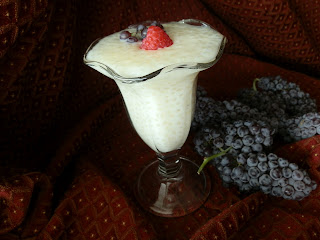Sago Pearls in Coconut Milk...also known as thar-gu ohn nyot, which is Burmese.
Thank goodness this was really yummy, because I had a few challenges in the cooking process. Not because this was difficult to make, but mainly because I really had no idea what I was doing.
It started when I went to a local international market. I found sago while looking for boba. It looked like boba (Taiwanese tapioca balls), but was smaller--about half the size of a pea. I had to have it.
When I got home, I Googled sago and sifted through recipes, settling on one from a site called Hsba. Hsba's recipe for Sago Pearls in Coconut Milk looked pretty simple, so I should have no problem, right? Right? Well...
Attempt #1
The first batch was going so well at first, but I did not fully understand the importance of frequently stirring the sago as it boiled. As it turns out, this is a pretty critical task when cooking tapioca balls because these tiny little suckers adhere very firmly to the bottom of the pan if you do not stir often.
Attempt #2
With the second batch, I learned another valuable lesson. It seems that there is a fine line between boiling sago and scorching the heck out of the pan and the sago, and stinking up the house for an extended period of time. So, I guess the key is to boil sago gently, and do not use extremely high heat.
It was at about this point that I had to make a rather hefty contribution to the family curse jar.
Attempt #3
Success! The sago was cooked, clear and beautiful!
This recipe also called for palm sugar, which I got from the international market, too. It was pretty hard, so I used a butter knife to sort of jab and cut it out of the jar.
The original recipe measurements were metric, so I converted to U.S. standards. Well, actually it's British, or Imperial...whatever, I made it so we could use cups and teaspoons.
Sago Pearls in Coconut Milk recipe
ingredients
3 1/2 ounces sago pearls (about 1/2 cup)
4-5 cups water
___
2 tablespoons and 1 teaspoon palm sugar
3 tablespoons water
(if you don't have palm sugar, just use packed brown sugar)
___
3 tablespoons and 1 teaspoon coconut milk (canned)
pinch of salt
___
1/2 cup coconut milk, chilled (canned)
...............
Heat 4-5 cups of water in heavy bottomed pot. Boil water and add sago. Stir often (I stirred every 5 minutes). Reduce heat to moderate and cook for a total of about 30 minutes (if using small sago about the half the size of a pea, if larger sago is used cook up to 45 minutes). Stir lots to prevent sticking to the bottom!
_____
While the sago is cooking, heat the palm sugar and about 3 tablespoons of water over moderate heat, till dissolved. Stir occasionally. The original recipe called for straining this mixture, but I had no sediment and didn't feel like straining, and it was perfect. Let it cool.
_____
When sago is almost transparent throughout, turn off heat. Stir again. Leave to continue cooking, and put on the lid. Let this sit 30 minutes, stirring occasionally. After the 30 minutes, put in colander and run cool water over it so it stops cooking. The sago should be completely transparent.
_____
Put sago in a bowl. Pour 3 tablespoons, or so, of the coconut milk over it and sprinkle with salt. Stir. This will keep the sago from sticking to each other.
_____
Put into serving dishes. Pour over the remaining 1/2 cup of coconut milk and palm sugar to taste. I did not use all the coconut milk or palm sugar, and it was delicious.
____
*Sago does not keep well overnight. This is a make-fresh dessert!
serves 2




Your palm sugar looks like boogers, but I like boogers...
ReplyDeleteTo begin with, thank you for taking a look at my blog! From your comment, I am assuming that palm sugar is as new to you as it is to me. It does have a different appearance than we are used to here in the U.S., but it is super delicious! If you don't want to make sago using palm sugar, brown sugar would be good, too. Take care!
ReplyDeleteI often thought about using brown sugar, but it has more moisture than palm sugar. I could use palm sugar in a recipe but I would have to compensate for the lost moisture, maybe about 1 TB. per cup of brown. Brown sugar is simply white sugar with molasses added. As my Aunt, Pepe Pistachio, use to tell me while fighting off rabid crocodiles in her two seat canoe off the Potomac, adding brown sugar to sago offers a depth of flavor and exquisite richness that is lacking in a palm sugar sago recipe.
ReplyDeleteThank you for that anecdote. Perhaps you are right, and I should not take the use of palm sugar so lightly. I will certainly keep this in mind for when I am in the kitchen and am tempted to view ingredients with an air of frivolity. Give my best to your Aunt Pepe Pistachio. And thank you for giving me a good laugh!
ReplyDeleteThanks for your recipe and for sharing your sago cooking experience. Turned out great the first time for me. Thanks!
ReplyDeleteMeishelz, thank you so much for stopping by and reading my blog! I am glad you liked the sago recipe. Take care and happy cooking!
ReplyDelete